Serruria hirsuta
Serruria hirsuta R.Br.
Family: Proteaceae
Common names: Swartkops spiderhead, hairy spiderhead (Eng.) Swartkop-spinnekopbossie (Afr.)
Introduction
A splendid specimen that shapes itself into a rounded form, showcasing its beautiful flower heads and pink flowers, which attract bees and other insects, and have a wonderful fragrance.
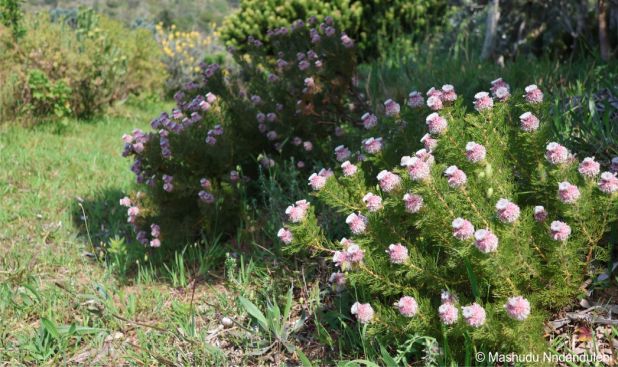
Description
Description
Serruria hirsuta is an erect, compact, rounded evergreen shrub, attaining a height of 300–500 mm, a spread of 500 mm, and the main stem diameter of 20 mm. The leaves are linear-lanceolate, erect, and measure 30–35 mm in length and 15–20 mm in width. They are silky, hairy, and deeply dissected (cut deeply into lobes) into 9–15 apical points. The leaves are hairy throughout, including the petiole, which measures 15–20 mm in length.
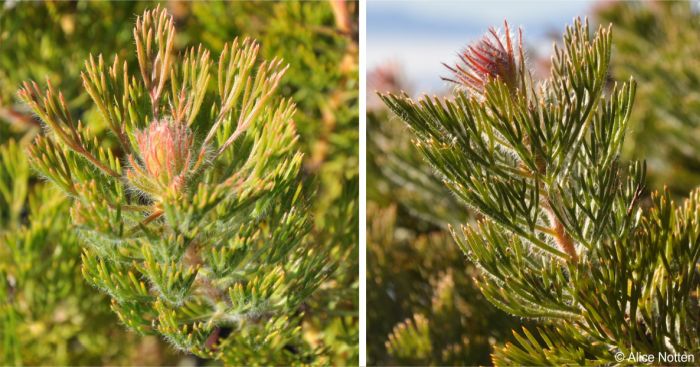
The inflorescence is stalkless, globular and measures 20–45 mm in length and 25–30 mm in width, the headlets are solitary, comprising of 30–40 flowers. The peduncle is 0–10 mm long, with involucral bracts encircling the base and possessing hairy margins. The perianths are silvery pink. The style measures 10 mm in length, and has a slender, club-shaped pollen presenter (style head) that measures 1 mm in length. The plant flowers in winter and spring (July to October).
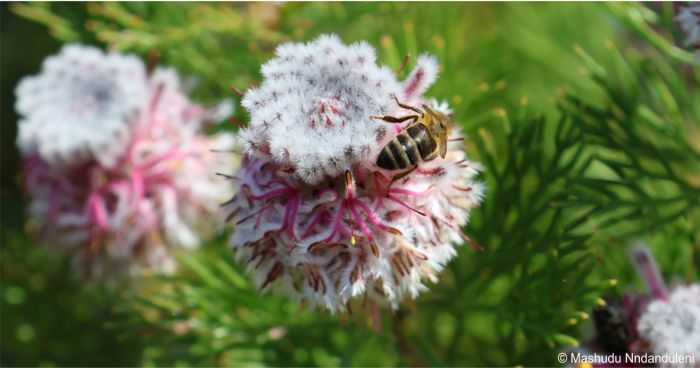
Serruria hirsuta is closely related to Serruria villosa (golden spiderhead) but is clearly distinguishable, even when not in flower, because Serruria hirsuta has distinctive hairy leaves.
Conservation Status
Status
Serruria hirsuta is a rare species and is assessed as Vulnerable (VU) by the Red List of South African Plants. Its population is stable, with over 3000 plants within a protected reserve, the Table Mountain National Park. However, the species faces potential threats of habitat loss due to firebreak construction along the urban fringe and the presence of invasive alien plant species. Regular efforts to clear invasive alien plants are conducted at the site, however, the potential for future habitat degradation caused by invasive species remains a pressing concern. It was thought that Serruria hirsuta was once widespread in the southern Peninsula, however no specimens outside of its current known range have been found and this belief has faded.
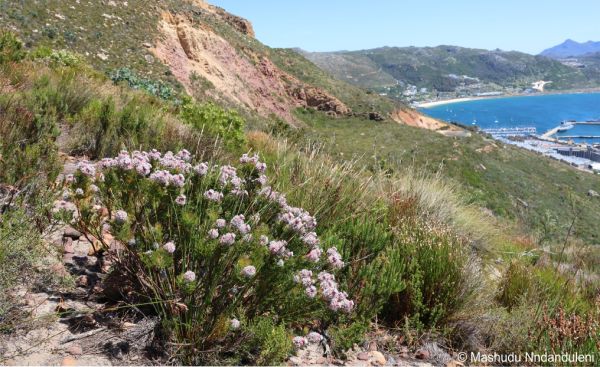
Distribution and habitat
Distribution description
Serruria hirsuta is endemic to the Swartkop Mountain, above Simon's Town, in the southern Cape Peninsula. The plants are found growing on sandstone soils on mountain slopes at elevations of 360–470 m.
Derivation of name and historical aspects
History
The genus Serruria, a member of the Proteaceae family, is endemic to the Cape Floristic Region (CFR) and comprises approximately 55 species. The genus name honours James Serrurier, a professor of botany at the University of Utrecht in the early eighteenth century. The specific epithet hirsuta is derived from the Latin word hirsutus, meaning ‘hairy’ or ‘long-haired’ referring to the pubescent leaves and stem surfaces of Serruria hirsuta.
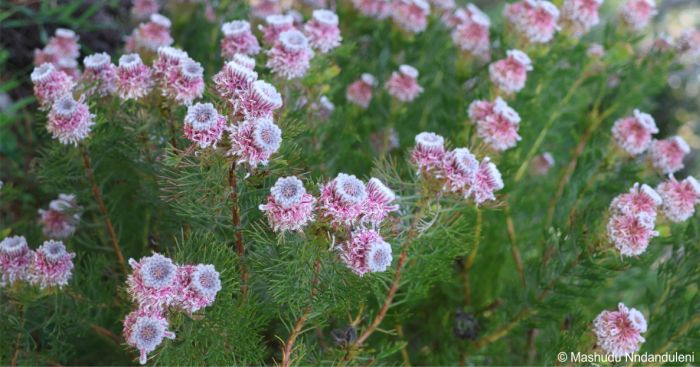
Ecology
Ecology
Serruria hirsuta exhibits a life cycle that is well-adapted to fire-prone environments, where fire events kill mature plants, but the species regenerates through seeds. The plant produces small, light, nut-like seeds equipped with an elaiosome, a nutrient-rich structure located at the base of the seed, that attracts ants. Once the seeds mature, they are released and collected by ants, which transport them to their underground nests. There, the ants consume the elaiosome but leave the rest of the seed unharmed, thus the seeds are protected from predators and environmental hazards, remaining dormant until germination is triggered by a fire.
Seed production relies on pollination, which is facilitated by insects, including honey bees, that visit the sweetly scented flowers.
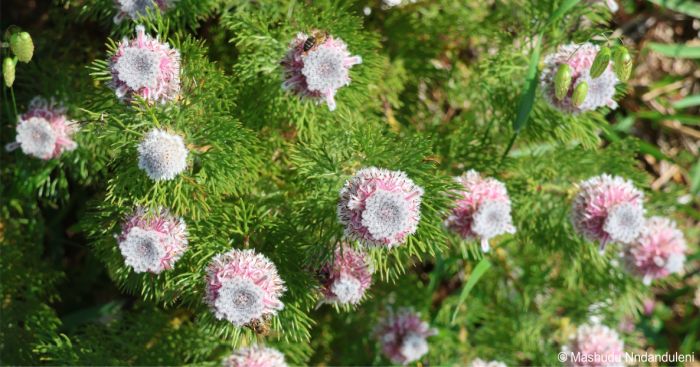
Uses
Use
This species grows naturally alongside amazing fynbos species such as Phaenocoma prolifera, Elegia stipularis, Muraltia heisteria, Liparia parva, Watsonia borbonica, Erica corifolia and Syncarpha gnaphaloides. All of these can be planted together, complemented by a background of Leucadendron xanthoconus, Leucospermum conocarpodendron susbp. viridum and Protea nitida, which create an outstanding natural display of flowers and texture. At Kirstenbosch, the plants are cultivated in a terraced landscape in granite-rich soil, ensuring superior drainage in the semi-shaded environment beneath silver trees, and in full sun in rocky flower beds.
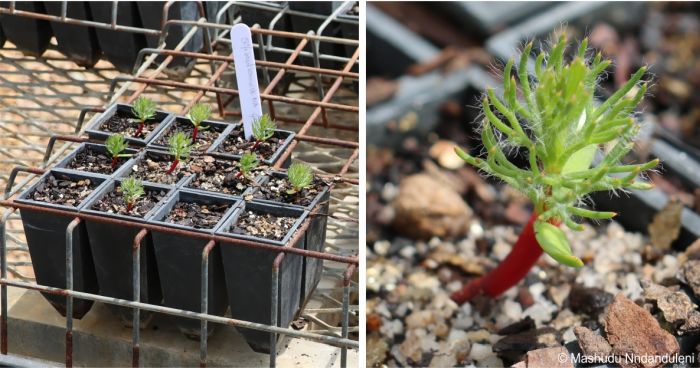
Growing Serruria hirsuta
Grow
Serruria hirsuta is propagated by seed and cuttings. However, ensure that the plants are growing in soil with an acidic pH between 5 and 7. A higher or very low pH level causes the plants to suffer and eventually die. The seeds are sown in late summer to autumn (February to April), when the night temperature drops, to mimic the conditions in the wild. The seeds are treated with systemic fungicides prior to sowing to prevent infection by pre- and post-emergence damping-off fungi. The seeds are also treated with smoke derived from burning dry and green fynbos materials to break dormancy. A well-aerated fynbos sowing medium is used, such as a mixture of 50% vermiculite and 50% milled bark. The germinated seedlings are potted in a mixture of 25% vermiculite, 25% bark, and 50% fynbos soil medium, which ensures an exceptional survival rate for the seedlings.
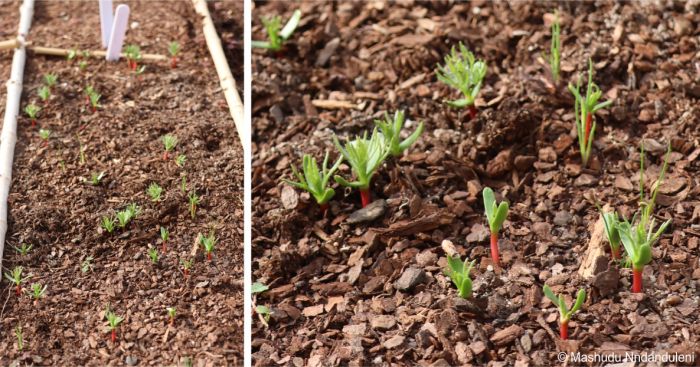
Semi-hardwood cuttings are collected in midsummer and autumn (November to April). Disease-free cutting material is selected, the cut base dipped into a liquid rooting hormone for 5 seconds, or a powder hormone is applied to the cut surface. The cuttings are placed in multi-trays, in a well-drained and aerated medium consisting of 70% perlite and 30% fine-milled pine bark or coarse sand. Cuttings are normally rooted on benches heated between 24°C and 30°C and are regularly treated with fungicides to prevent fungal infection. Rooting takes about two to three months under mist-house conditions.
An organic seaweed-based fertilizer is applied to encourage the development of the sensitive proteoid roots. This is a slow-growing protea, so it is important to monitor water requirements and keep the plant free of weeds to avoid root disturbance. The plants require a garden position with well-drained, acidic soil, full sunlight, or semi-shade and good aeration. They grow well in gardens when placed on a slope or in a rockery and where their roots will be as undisturbed as possible. In the garden, the plants are mulched with wood chippings to keep the soil cooler and moister during the hot, dry season and to suppress weeds. Once the plants are established in the garden, they require very little maintenance.
References
- De Villiers, M.J. 2004. Molecular systematics of the Western Cape genus Serruria Salisb. (Proteaceae L.) based on DNA sequence data. Doctoral dissertation, Stellenbosch University, Stellenbosch.
- Duncan, G., Brown, N. & Nurrish, L. 2013. Grow proteas. Kirstenbosch Gardening Series. South African National Biodiversity Institute, Cape Town.
- iNaturalist. Serruria hirsuta. https://www.inaturalist.org/taxa/594464-Serruria-hirsuta. Accessed 27 Nov 2024.
- Jackson, W.P.U. 1990. Origins and meanings of names of South African plant genera. University of Cape Town.
- Knight, L. 2014. Liparia hirsuta Thunb. (Fabaceae). PlantZAfrica. Online. https://pza.sanbi.org/liparia-hirsuta.
- Manning, J. & Goldblatt, P. 2012. Plants of the Greater Cape Floristic Region 1: the Core Cape Flora. Strelitzia 29. South African National Biodiversity Institute, Pretoria.
- Matthews, L.J. & Zoe Carter (Artist). 1993. Proteas of the world. Auckland, New Zealand.
- Protea Atlas Project. IDM Cape Peninsula - Swartkops Spiderhead - Serruria hirsuta. https://www.proteaatlas.org.za/cpsehirs.htm. Accessed on 27/11/2024.
- Protea Atlas Project. Meanings of scientific names. http://www.proteaatlas.org.za/meanings.htm. Accessed on 2024/12/09.
- Rebelo, T. 1995. SASOL Proteas, a field guide to the proteas of southern Africa, Edn 2. Fernwood Press, Vlaeberg, Cape Town.
- Rebelo, A.G., Helme, N.A. & Raimondo, D. 2020. Serruria hirsuta R.Br. National Assessment: Red List of South African Plants. http://redlist.sanbi.org/species.php?species=807-57.
Credits
Mashudu Nndanduleni and Ntombenhle Shange
Kirstenbosch National Botanical Garden
February 2025
Plant Attributes:
Plant Type: Shrub
SA Distribution: Western Cape
Soil type: Sandy, Loam
Flowering season: Spring, Winter
PH: Acid
Flower colour: White, Pink
Aspect: Full Sun, Morning Sun (Semi Shade)
Gardening skill: Average
Special Features:
Horticultural zones
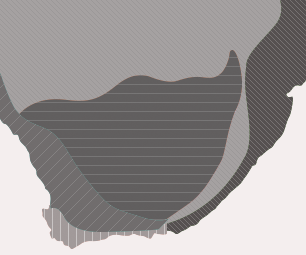






Rate this article
Article well written and informative
Rate this plant
Is this an interesting plant?
Login to add your Comment
Back to topNot registered yet? Click here to register.